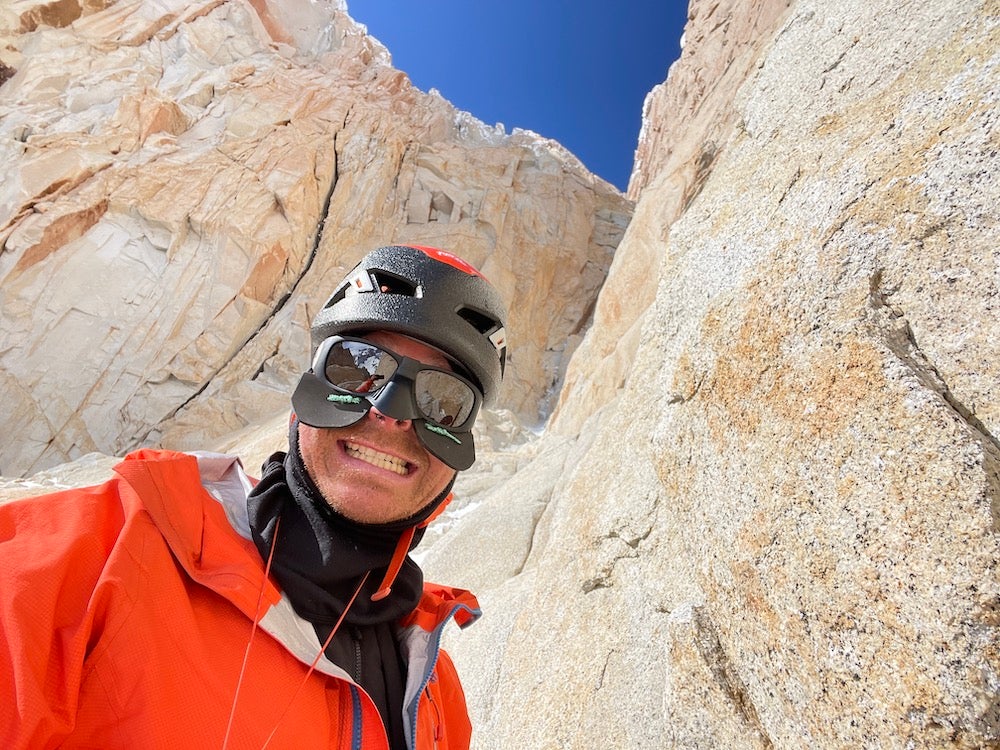
The American alpinist shares what it took to climb the 5,000-foot route on Cerro Chaltén.
The post Colin Haley on the First Winter Solo of ‘Supercanaleta,’ Patagonian Classic appeared first on Climbing.

As far as sustained, technical alpine climbs go, the Supercanaleta (5.9 WI 4 M5-6; 5,000 feet) on Patagonia’s Cerro Chaltén (Fitz Roy) (11,171 feet) is as classic as they come. Colin Haley, who made the second solo ascent of the Supercanaleta in the summer of 2009, has become the first person to make a solo winter ascent of the line, in a 22-hour blitz that left him “wasted physically, mentally, and psychologically.”
Haley filled in Climbing via email on the historic ascent and descent, which he said “leveraged the total skillset” he had amassed over 22 years of climbing and alpinism. Haley discussed his vacillating relationship with hard soloing, what makes a solo ascent “legitimate,” and why he returned to the Supercanaleta for a second attempt, only days after hiking his cache out of the mountains.
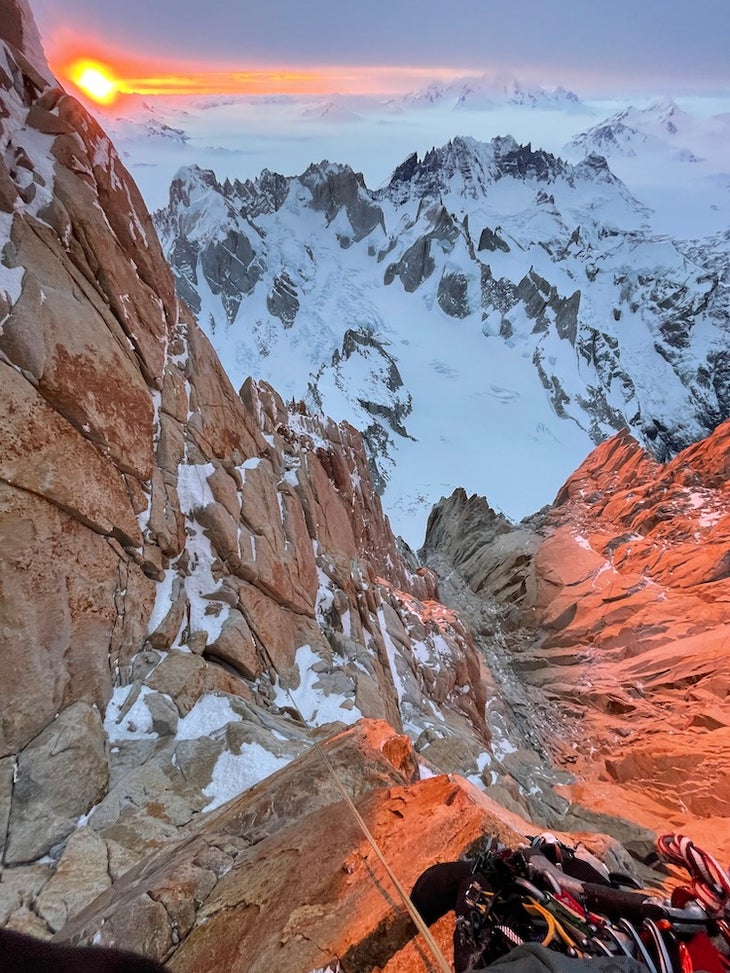
Climbing: On Instagram, you wrote that this objective was a nine-year dream. But you first soloed Supercanaleta even before that—back in 2009. So when did you first get the idea to attempt this winter solo, and why?
Haley: I first climbed in the Chaltén Massif in December 2003 and really fell in love with the place. Over several summer trips I became curious to see that landscape in the winter season, and finally made a winter trip in 2013. When I went down in winter that first time, the Supercanaleta was one of the routes on my mind.
It’s a fairly logical objective to attempt in winter because it is an objective that, even in summer, is typically climbed entirely in crampons. Many routes in the Chaltén Massif are typically climbed in rock shoes and have lots of pitches that would be really difficult and slow without rock shoes. It sounds like sometimes it is possible to wear rock shoes in the Chaltén Massif in the winter season, but in my three winter trips, I’ve never experienced temperatures warm enough to do so.
The Supercanaleta is also just a super classic, very obvious line. Lastly, I think it was more on my radar because I knew that one of my biggest mentors, Rolo Garibotti, had flirted with the idea of trying it solo in winter back in 2001.
Climbing: In a 2019 blog post you compared hard soloing to alcoholism, and mentioned “majorly de-prioritizing” soloing in your life. What about Supercaneleta was enough to draw you into another big, hard solo?
Haley: Yeah, the conclusion that I made in 2019 is one that I still believe—that I prefer climbing with a good partner over solo climbing, and that I ought to put more energy into finding good partners, and less energy into solo climbing. It was basically for that reason that I hadn’t been back to attempt this objective since my trip in 2019.

It was only after some other summer plans kind of fell through that I thought, “Well, I can still go try the Supercan!” One advantage of solo climbing is that it is more possible to go on an expedition at the last minute because there is no need to coordinate schedules with anyone else.
But yeah, the Supercanaleta as a winter solo was certainly an exciting idea. The main idea is just to have an objective that is really challenging. For me, it is much more exciting to go try something that is intimidating and [where] I know there is a good chance of failing, than to go try something [where] I will likely succeed.
The other big appeal of trying the Supercanaleta solo in winter was the diversity of challenges. I have dedicated most of my life to trying to get at least decent at many different types of climbing, from bouldering to waterfall-ice climbing, to Yosemite big walls, high-altitude snow-slogging, and sport climbing. This objective definitely made use of the skills and know-how that I’ve gained from winter alpine climbing and climbing in otherwise cold places, like Denali.
On the route itself, my ice-climbing skills, mixed-climbing skills, crack-climbing skills, and even bouldering and sport-climbing skills were all very useful to me. On the descent, it was definitely to my advantage to have so much past experience in the Chaltén Massif. In the Chaltén Massif there are almost no walk-offs, so I’ve always said it’s a master’s class in rappelling. I think all my experience descending peaks in the Chaltén Massif has educated me a lot on how to get down a lot of steep terrain in a safe manner.
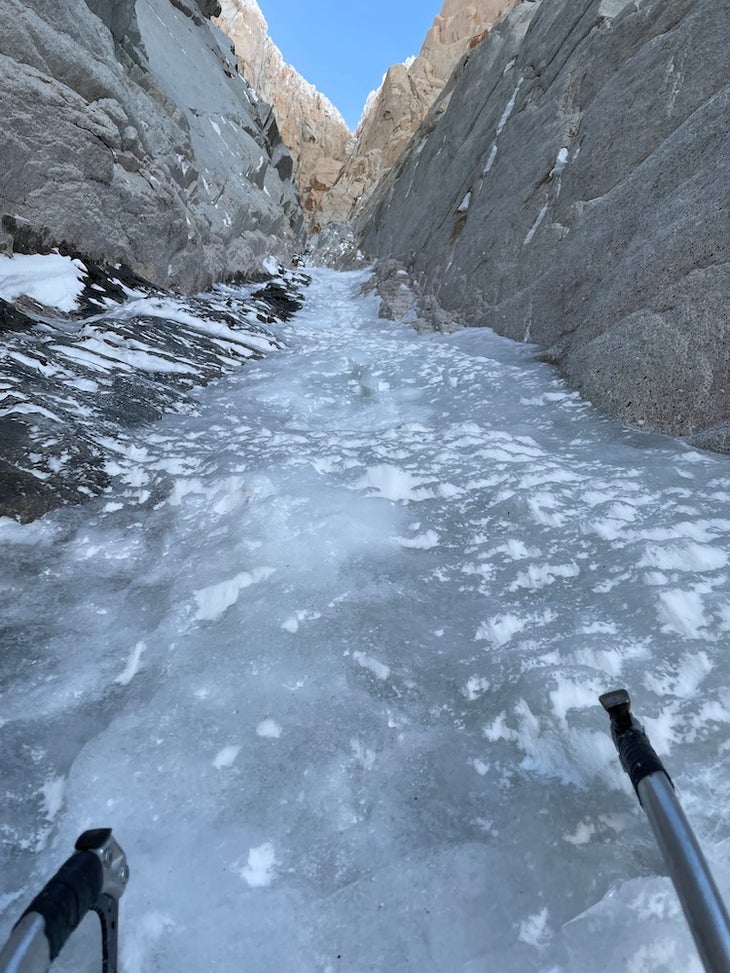
Climbing: You wrote about feeling “wasted physically, mentally, and psychologically” after the climb. We can probably imagine what you experienced as far as the first two. But can you tell us a bit about feeling “psychologically” wasted?
Haley: Well, of course, there is inherent risk in a lot of climbing, and certainly in solo climbing, but I also really, really want to stay alive. It is of course rather absurd. On a hard solo like this, I guess I am constantly in a sort of psychological balancing act, of trying to be ambitious and succeed on a difficult objective but also constantly evaluating the various risks. I’ve never been one to try to “overcome” fear. I think that fear is a healthy emotion that helps keep us alive.
So, I guess it just makes the whole experience pretty taxing psychologically. When I got down to the base of the mountain, I could finally relax after 22 hours in a state of near-constant stress—that is simply tiring!
Climbing: You also mentioned needing “psychological firepower” to attempt this. What does that firepower look like? How do you build it up?
Haley: Ha. I’m not really sure. I do know that sometimes I’ve gone to attempt a hard solo, but then finished the approach, looked up at the route, and just didn’t feel up for it. I hiked in to try to solo Torre Egger a few times and felt this way. When I finally did solo Torre Egger I hiked in feeling totally psyched and confident that it was the right moment.
Similarly for the Supercanaleta, in 2019 I just didn’t have it in me at that moment. This time I felt much more like “this is exactly what I want to do right now.” Even though I was just explaining that hard soloing is psychologically tiring because it can be scary, you can’t have it be too scary. If the fear is more than some background anxiety, I simply bail. If I were able to predict the moments when I have more “psychological firepower,” it would certainly save me a lot of time, hassle, and money!
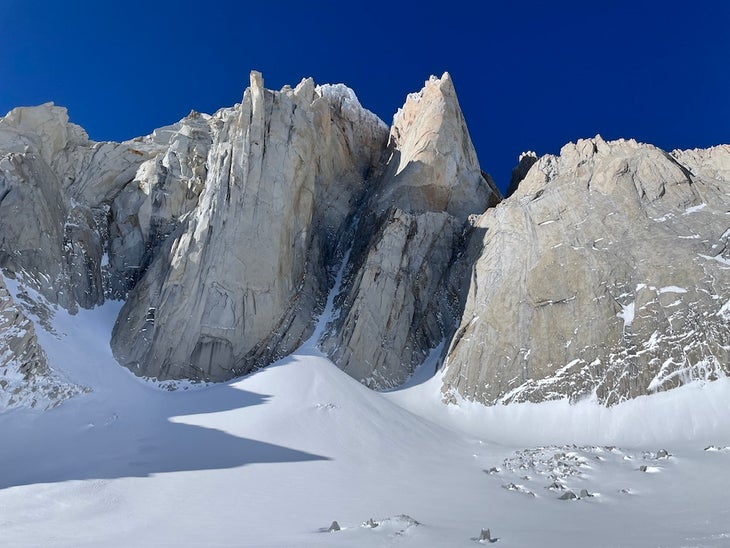
Climbing: Can you expand on the idea of a “legitimate solo ascent” per what you wrote in your blog? What are the requirements—in your eyes—for a solo to be legit? Is lack of contact with other parties a major part of it, and is that partially why it was key to hit this solo in winter?
Haley: Well, there is always a lot of gray area in climbing, and I won’t try to lay down a strict set of rules for others to follow. But certainly I want to feel that I’ve done something properly. For me, getting assistance from other parties certainly taints something that might otherwise be a “legitimate solo,” but defining what is “assistance” is not necessarily clear.
To me, if I soloed a route on Fitz Roy but then descended with another party, that would definitely delegitimize a solo ascent. On the other hand, when I did a speed record on the Cassin Ridge in 2018, I was greatly aided by tracks from other parties on significant sections of the route. That didn’t bother me too much, because my objective, in that case, was specifically making a speed record, and I didn’t really care about being solo or not. The Cassin is a pretty easy solo for me, and I would have happily gone for the speed record with a partner if I had a good partner for it.
So, there are many things to consider, and it is not always so black and white as to what is legitimate or not. For many solo alpine climbs, the most dangerous part is the approach—traveling on a glacier by oneself. It is for this exact reason that several solo ascents of Cerro Torre have been done by roping up with another party for the approach.
On this winter trip in Chaltén, I could have definitely increased my chances of sending if I had hired a porter to help carry all my gear to the base of the route. These days more and more people are hiring porters in Chaltén, although I’ve yet to ever do so. If I had hired a porter for the approach, I would definitely feel less confident that I had overcome all of the difficulties of this objective on my own power. But, if someone else wants to hire a porter for the approach to a solo ascent, I don’t think that necessarily delegitimizes their ascent. As is always the case in climbing, it doesn’t really matter what you do. All that matters is that you are totally honest and forthright with the details about what you did.
Climbing: You shared a text message exchange with your mentor Rolando Garibotti, where he told you that this could be an “empowering trip.” Was it? And would it only have been empowering if you finished the objective successfully?
Haley: Ha. I’m not really sure exactly what Rolo meant by “empowering.” Maybe that it is an objective that fits well my skill set, and therefore would be some sort of self-affirmation? Whatever exactly Rolo meant by “empowering,” I imagine that, indeed, it would have felt less that way if I had not succeeded!
I can say that due to COVID and a stubborn knee injury, this is the biggest climbing success I’ve had in a few years, and for sure that feels good.
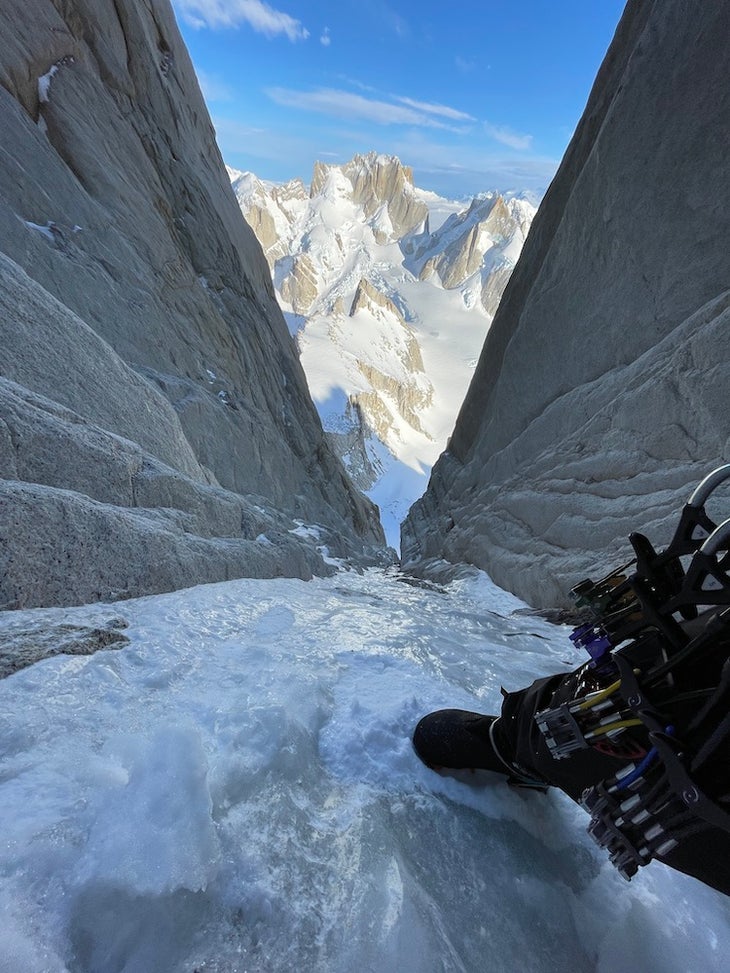
Climbing: You came across the bodies of two dead soloists on the route in the past— how did that affect you and your motivations to come back and solo the route in winter?
Haley: I won’t go into too much detail, because these are real people who lost their lives, and who are still missed by many living people today. Seeing their bodies was definitely traumatizing. More than anything else, I have thought about where each of them might have fallen from, and what exactly might have led to that mistake.
I definitely think that both of those experiences decreased my motivation for hard soloing in general, and for soloing the Supercanaleta specifically, but obviously not so much as to convince me against attempting it.
Climbing: Bailing and hiking your cache out, and then returning only a few days later to go at it again—what went through your head during that interlude? Was packing your gear out a way to hold yourself to not coming back for another attempt? What made you come back?
Haley: Hiking the cache out was just a pragmatic decision. At that moment I felt confident that I wouldn’t make another attempt. It was also extremely stormy, so I would’ve anyways only been able to cache stuff like crampons, axes, carabiners, and pitons. It is not worth caching a tent and sleeping bag if they are just going to be blocks of ice when you come back. Also, the approach to the Supercanaleta is pretty long, and there aren’t other routes nearby that I might have considered soloing, so if I had left a cache there it would have meant that I definitely couldn’t attempt any other routes in the whole range, as I only had one set of equipment with me in El Chaltén.
In terms of changing my mind, I’m not sure if I can really explain it in a logical way. It’s just that when you have just come down from a super intense, stressful experience, it is hard to imagine wanting to have that sort of experience again. Once you have come back down to a safer, more comfortable existence, it is easy to start dreaming again and feeling psyched again to cast off into the intensity and stress. I’m afraid I can’t offer a more rational explanation than that, but I’m sure that many alpine climbers could relate to what I am saying.
Climbing: Coming down from this solo have you had any new epiphanies about the nature of soloing, or the nature of climbing hard, dangerous, committing objectives?
Haley: Hmm… sorry, but no, I don’t think I’ve had any new epiphanies! Nothing that I haven’t already realized or learned in the past. We climbers have a tendency to learn the same lessons multiple times. My girlfriend teases me about this!
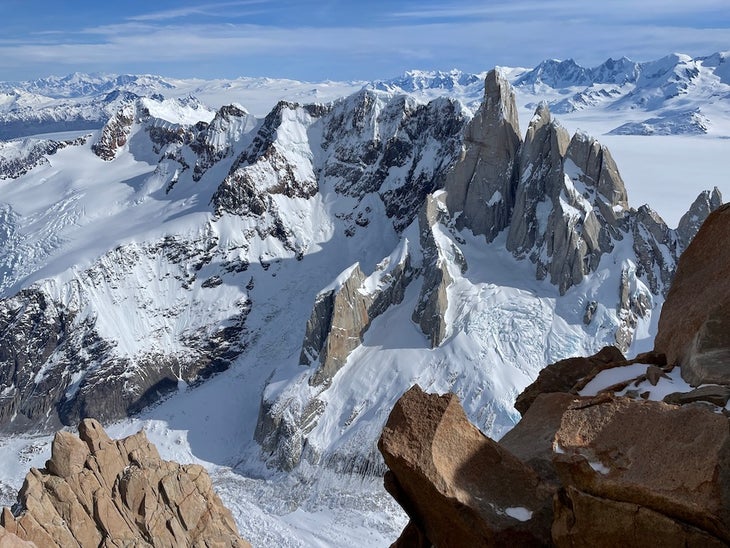
Climbing: You mentioned it was difficult to gauge where the ascent stood among your other climbing accomplishments, at least at first. After some time and reflection (the opinion of the climbing community notwithstanding), how do you view this accomplishment?
Haley: I haven’t yet really thought about this much more. For the sake of simplicity, I think I would compare it to other solo climbs that I have done since that is easier than comparing it to climbs done with partners. I still think I am more proud of my Infinite Spur solo [Haley made the first solo ascent of the Infinite Spur on Alaska’s Sultana (Mt. Foraker) in 2016] than of this one.
I think I am [also] more proud of my Torre Egger solo than this one. I like the simplicity of having been the first person to solo that awesome mountain, regardless of route or season. I’d say that my winter solo of the Supercanaleta feels maybe slightly more proud than the first solo of Aguja Standhardt and first solo of Waddington, but perhaps on par with the first solo of the North Buttress of Begguya (Mt. Hunter).
The post Colin Haley on the First Winter Solo of ‘Supercanaleta,’ Patagonian Classic appeared first on Climbing.